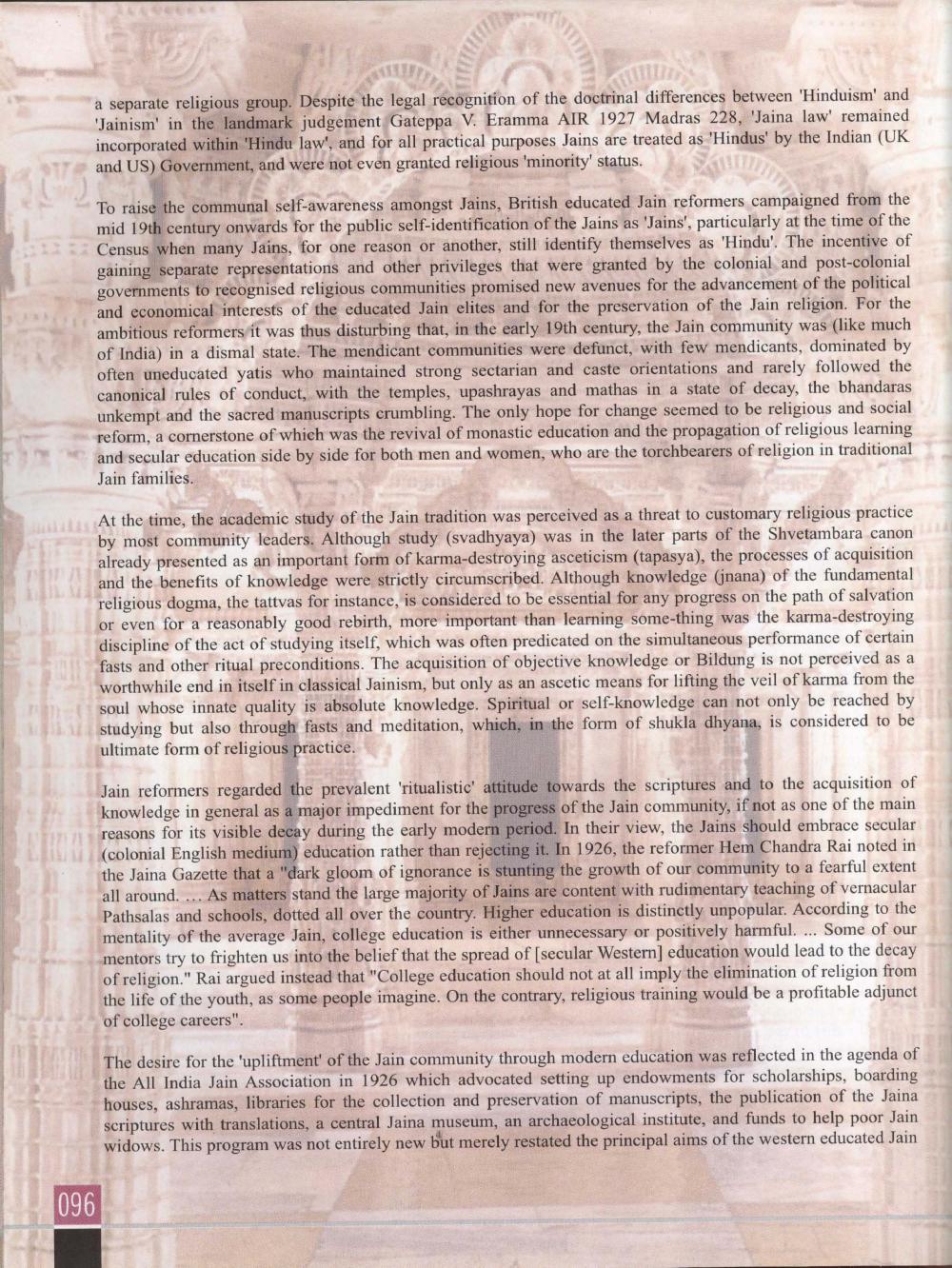________________
a separate religious group. Despite the legal recognition of the doctrinal differences between 'Hinduism' and 'Jainism in the landmark judgement Gateppa V. Eramma AIR 1927 Madras 228, 'Jaina law' remained incorporated within 'Hindu law', and for all practical purposes Jains are treated as 'Hindus' by the Indian (UK and US) Government, and were not even granted religious 'minority' status.
To raise the communal self-awareness amongst Jains, British educated Jain reformers campaigned from the mid 19th century onwards for the public self-identification of the Jains as 'Jains', particularly at the time of the Census when many Jains, for one reason or another, still identify themselves as 'Hindu'. The incentive of gaining separate representations and other privileges that were granted by the colonial and post-colonial governments to recognised religious communities promised new avenues for the advancement of the political and economical interests of the educated Jain elites and for the preservation of the Jain religion. For the ambitious reformers it was thus disturbing that, in the early 19th century, the Jain community was (like much of India) in a dismal state. The mendicant communities were defunct, with few mendicants, dominated by often uneducated yatis who maintained strong sectarian and caste orientations and rarely followed the canonical rules of conduct, with the temples, upashrayas and mathas in a state of decay, the bhandaras unkempt and the sacred manuscripts crumbling. The only hope for change seemed to be religious and social reform, a cornerstone of which was the revival of monastic education and the propagation of religious learning and secular education side by side for both men and women, who are the torchbearers of religion in traditional Jain families.
At the time, the academic study of the Jain tradition was perceived as a threat to customary religious practice by most community leaders. Although study (svadhyaya) was in the later parts of the Shvetambara canon already presented as an important form of karma-destroying asceticism (tapasya), the processes of acquisition and the benefits of knowledge were strictly circumscribed. Although knowledge (jnana) of the fundamental religious dogma, the tattvas for instance, is considered to be essential for any progress on the path of salvation or even for a reasonably good rebirth, more important than learning some thing was the karma-destroying discipline of the act of studying itself, which was often predicated on the simultaneous performance of certain fasts and other ritual preconditions. The acquisition of objective knowledge or Bildung is not perceived as a worthwhile end in itself in classical Jainism, but only as an ascetic means for lifting the veil of karma from the soul whose innate quality is absolute knowledge. Spiritual or self-knowledge can not only be reached by studying but also through fasts and meditation, which, in the form of shukla dhyana, is considered to be ultimate form of religious practice.
Jain reformers regarded the prevalent 'ritualistic' attitude towards the scriptures and to the acquisition of knowledge in general as a major impediment for the progress of the Jain community, if not as one of the main reasons for its visible decay during the early modern period. In their view, the Jains should embrace secular (colonial English medium) education rather than rejecting it. In 1926, the reformer Hem Chandra Rai noted in the Jaina Gazette that a "dark gloom of ignorance is stunting the growth of our community to a fearful extent all around. ... As matters stand the large majority of Jains are content with rudimentary teaching of vernacular Pathsalas and schools, dotted all over the country. Higher education is distinctly unpopular. According to the mentality of the average Jain, college education is either unnecessary or positively harmful. ... Some of our mentors try to frighten us into the belief that the spread of [secular Western) education would lead to the decay of religion." Rai argued instead that "College education should not at all imply the elimination of religion from the life of the youth, as some people imagine. On the contrary, religious training would be a profitable adjunct of college careers".
The desire for the 'upliftment' of the Jain community through modern education was reflected in the agenda of the All India Jain Association in 1926 which advocated setting up endowments for scholarships, boarding houses, ashramas, libraries for the collection and preservation of manuscripts, the publication of the Jaina scriptures with translations, a central Jaina museum, an archaeological institute, and funds to help poor Jain widows. This program was not entirely new but merely restated the principal aims of the western educated Jain
096




